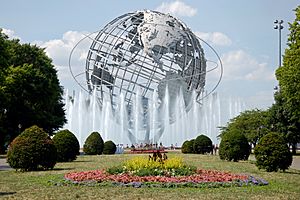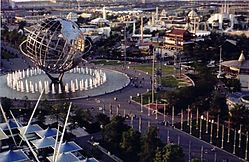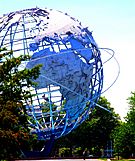Unisphere facts for kids
The Unisphere is a giant, shiny globe made of stainless steel. It stands about 140 feet (43 meters) tall in Flushing Meadows–Corona Park in Queens, New York City. This huge globe weighs around 700,000 pounds (317,500 kg), making it the biggest globe in the world! Around its base, you'll find beautiful fountains and a calm pool that reflects its image.
The Unisphere was created for the 1964-1965 New York World's Fair. It was designed to show how countries around the world depend on each other. After the fair ended, the Unisphere stayed in the park. It was cleaned and fixed up between 1993 and 1994 to keep it looking great.
Contents
The Unisphere's Story
Flushing Meadows–Corona Park was once a landfill in Queens. This area was later transformed for the 1939/1940 New York World's Fair. After that fair, it became a public park. The park then hosted the 1964 New York World's Fair. Gilmore David Clarke and Michael Rapuano were the designers who planned the park for this 1964 event.
How the Unisphere Was Planned
Robert Moses, who was in charge of the 1964 World's Fair, announced the idea for the Unisphere in February 1961. At first, Gilmore Clarke imagined the Unisphere as an aluminum structure. It would have metal shapes for continents and islands. Designers from Peter Muller-Munk Associates later added strong steel to the plans. The final design looked very much like the first idea. It also included fountains around the globe.
Building the Giant Globe
The American Bridge Company built the Unisphere. This company was part of a larger company called US Steel. It took only 110 days to build the main structure. The very last piece of land was placed on the Unisphere on August 13, 1963. At night, special lights made the Unisphere glow. They showed how sunrise moves across the Earth. There were also lights marking the capital cities of countries.
Keeping the Unisphere Beautiful
In 1966, US Steel gave $100,000 to help keep the Unisphere in the park. The park reopened in 1967. Over time, the Unisphere became dirty. People even wrote graffiti in the pools around it.
In 1989, the New York City Department of Parks and Recreation decided to clean the Unisphere. From 1993 to 1994, the globe was repaired and cleaned. The fountains were turned back on too. In May 1995, the Unisphere became an official city landmark. This means it's a very important historical site. The Unisphere's fountain was cleaned again in 2010.
Unisphere Design and Features
The Unisphere is the biggest globe in the world. It is about 120 feet (37 meters) wide and 140 feet (43 meters) tall. The globe itself weighs 700,000 pounds (317,500 kg). Its base adds another 200,000 pounds (90,700 kg). The entire structure is made from strong stainless steel. The continents and islands you see on the Unisphere were made by the Rigidized Metals Corporation. The globe is tilted at 23.5 degrees, just like the real Earth.
Rings and Water Features
There are three rings that go around the Unisphere. These rings show the paths, or orbits, of famous space objects. They represent the orbits of Yuri Gagarin, John Glenn, and the Telstar satellite. These rings are held up by strong aircraft cables. The continents and islands on the Unisphere are made of many layers of metal sheets. The globe also has many lines for latitude and longitude. These lines help make the structure very stable.
A large reflecting pool surrounds the Unisphere. It measures about 310 feet (94 meters) across. There are 48 fountains in this pool. These fountains are designed to make the Unisphere look like it is floating in space. You can also find plaques around the pool that tell more about the globe.
The Foundation of the Globe
The Unisphere stands on a strong concrete foundation. The ground under the Unisphere used to be a marsh. To make sure the heavy globe was stable, 528 wooden rods were placed deep under the Unisphere.
Images for kids
See also
 In Spanish: Unisphere para niños
In Spanish: Unisphere para niños





